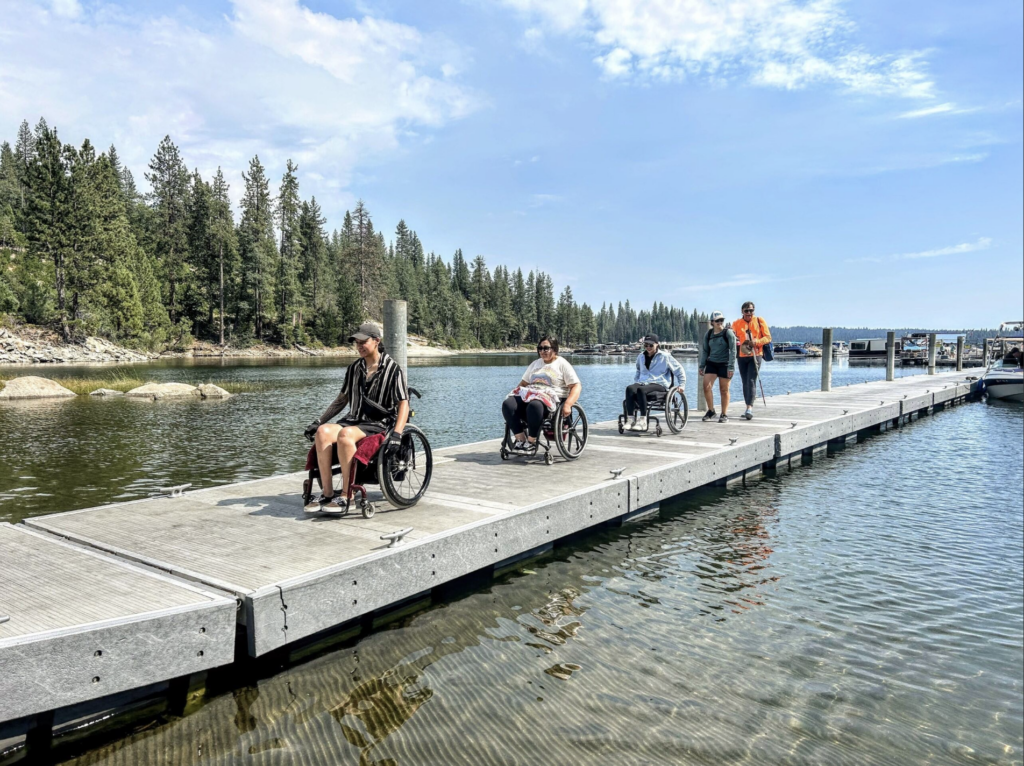
Inclusive design is more than adding ramps or meeting accessibility standards—it’s about who gets to make the decisions about accessibility. It ensures that those who experience exclusion, such as people with spinal cord injury (SCI) are actively shaping the spaces, systems, and innovations that impact their lives. True inclusion not only removes barriers but also expands opportunities, creating pathways for greater participation and equity.
The most effective solutions emerge when lived experience leads the way. Our grantee partners demonstrate that true inclusion happens when people with SCI are engaged in decision making, problem solving, and innovation.
While universal design strives to create environments that work for as many people as possible, when inclusivity is embedded in the process from the start, it has a more significant impact. By engaging people with SCI directly in the design process, inclusive design helps refine and enhance universal solutions, ensuring they are meaningful in real-world contexts.
Creating Inclusive Community Spaces
Public spaces, fitness centers, and recreational programs often claim to be accessible, but who defines what that means? A space may have designated accessible parking, but if essential signage lacks braille or audio options, or elevators have controls that require fine motor skills is it truly inclusive?
Some of our grantee partners are working directly with city parks, rehabilitation centers, adaptive sports programs, and other community spaces to ensure accessibility is practical, not just present. This means:
- Involving people with a disability in the design of fitness equipment so it meets different body mechanics and needs.
- Training staff at YMCAs and gyms to support adaptive athletes.
- Redesigning outdoor areas like piers and parks based on input from wheelchair users with SCI—because a pathway is only accessible if it leads somewhere meaningful.
- Including audio wayfinding or braille.
One example of this work is a grantee partner’s project to improve access to Great Lakes fishing by redesigning a public pier with lowered fishing railings, shaded rest areas, and accessible seating options. These changes ensure that everyone can fish comfortably anywhere in the park, rather than being restricted to designated areas. This approach highlights how thoughtful, user-driven design transforms accessibility from a technical or legal requirement into a meaningful experience.
Removing physical barriers is just the start. True inclusion means designing for full engagement, where people aren’t just accommodated but are actively shaping their environments.
Accessibility in Healthcare
Accessibility continues to improve in healthcare, but fully integrating the patient’s experience remains a work in progress. Exam tables that are too high, rooms that don’t accommodate mobility devices, lighting that heightens visual impairments, and medical providers untrained in disability-specific care can all create barriers to quality care. These barriers can lead to delays or denials of essential services, often affecting underrepresented groups the most, contributing to disparities in health outcomes.
Preventive healthcare plays a vital role in reducing long-term health risks and supporting independence. One grantee partner is investigating these disparities, examining how factors like income, location, and race/ethnicity affect access to preventive services such as dental and vision care. Their early findings reveal key accessibility challenges, including:
- Lack of transfer equipment in exam rooms.
- Limited accessible parking at healthcare facilities.
- Providers unprepared to address the complex care that often accompanies living with a disability.
Most healthcare research focuses on primary care, but this project highlights how preventive services are often overlooked. More than one-third of participants reported being turned away from a provider due to accessibility issues, underscoring the need for healthcare environments to adopt universal design principles from the start. Addressing these challenges goes beyond adding more services; it requires additional medical training, access to adaptive devices, ensuring healthcare spaces meet diverse needs, and eliminating systemic barriers. True inclusion in healthcare involves people with disabilities in the decisions that shape their care, leading to more responsive, proactive, and inclusive systems that support long-term health and independence.
Strengthening Inclusion Through SCI Research
Scientific advancements in SCI care often claim to prioritize inclusion, but who determines what problems research should address? Too often, studies have focused on the SCI experience from an outside perspective, without fully integrating the voices of those actually living with it.
The North American Spinal Cord Injury Consortium (NASCIC) is trying to change this. As a grantee partner, they developed a course that trains individuals with SCI to actively participate in the design of research projects. Instead of researchers determining what questions matter on their own, this initiative aims to train people with lived experience in how to participate in the development and conduct of a research study so that they can share their experience and heighten the potential for impact.
The NASCIC course is a 12-module program created with input from over 100 individuals from the SCI community, including researchers, advocates, and people with lived experience. It provides:
- Training on how to engage in SCI research as partners rather than passive participants.
- Tools for advocacy, helping individuals with SCI ensure their voices are heard in scientific discussions.
- Stronger community connections, building networks between researchers and the people most impacted by their work.
By involving individuals with SCI in shaping research, we ensure that advancements address real-world priorities and lead to practical solutions that enhance quality of life.
Who Shapes the Future of Accessibility and Inclusion?
True inclusion isn’t just about meeting standards; it’s about ensuring that people with a disability have a voice in shaping the spaces, systems, and innovations that affect them. When individuals with lived experience take an active role in these decisions, accessibility shifts from a set of guidelines to a lived reality that reflects their practical needs and everyday experiences.
Our grantee partners demonstrate that inclusion isn’t a checkbox; it’s a process shaped by those with real-world insight. By centering their expertise, we move beyond accommodation and toward true equity—where people don’t just navigate spaces but actively shape them.